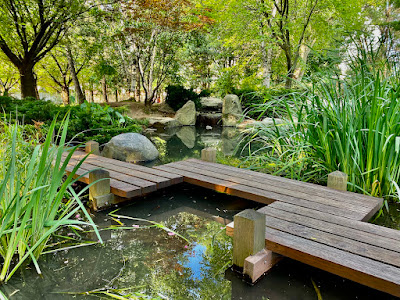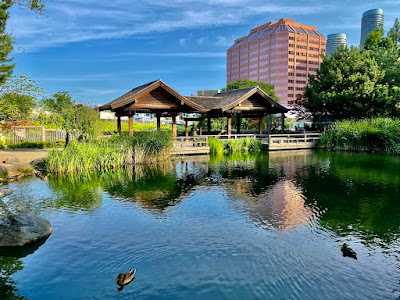Kariya Park in Mississauga is an example of of a mid-sized Japanese Garden located in the midst of an urban environment. The product of a 1981 sister city relationship between the cites of Mississauga, Ontario in Canada and the city of Kariya in Aichi Prefecture, Japan.
Website: https://www.mississauga.ca/events-and-attractions/parks/kariya-park/
The park opened in 1992 to celebrate the sister-city relationship. Since that time, it has developed into a mature garden with Cherry, Maple, Ginko, and local Birch trees.
The gate, fence and pavilion are all made from cedar and have been allowed to naturally turn a faded gray.
I especially liked the use of black bamboo for some aspects of the fence and windows.
The fence does an excellent job or isolating the garden from the urban landscape which surrounds the garden.
There were also several water features and a large Tachidōrō lantern. Unfortunately, the difficult-to-see lantern showed signs of vandalism. The water basin in the foreground was unique in it shape and was unlike any basin I had previously seen.
Several bridges added interest to the stroll paths throughout the greater garden, including a zig-zag bridge.
A large bridge with unique post designs crossed a pond leading toward the pavilion area.
The pavilion was constructed to reflect the nature of the sister city relationship between Mississauga and Kariya, its two adjacent roofed structures representing each city connected by a peace bell.
An abundance of ducks took advantage the of the pond and its stunning views of the garden and city-scape backdrop.
Stones, lanterns, and tori gates also populated the pathways surrounding the pond an pavilion area.
The pavilion platform was an excellent place to rest, take in the view, or practice Tai-Chi or Qigong.
A large peace bell, cast in Japan, and donated by the city of Kariya in 2001, was hung in the central area of the pavilion to honor the 20th anniversary of the friendship relationship between Mississauga and Kariya. It was impressive and something I have only seen in a few Japanese gardens in North America.
The backdrop of the pavilion includes a large karesansui (dry landscape) garden. The design was well thought out, and the simple collection of stones impressive. On my visit it was clear that the gravel had not been recently maintained, but otherwise it was a nice design feature. Unfortunately, a large construction site adjacent to this area of the garden proved somewhat distracting, but in a few years, once finished, I am sure the view from the karesansui garden will be vastly improved.
The south eastern portion of the garden is more reminiscent of a stroll garden, with wide pathways, plantings of Hydrangea, Hosta, and Dwarf Red Maples. There is also another pond populated by ducks and turtles.
Overall, Kariya Park was an excellent mid-sized garden with lots of authentic features and a most scenic and peaceful escape from its surrounding urban environment. Its a garden well worth a visit.






































